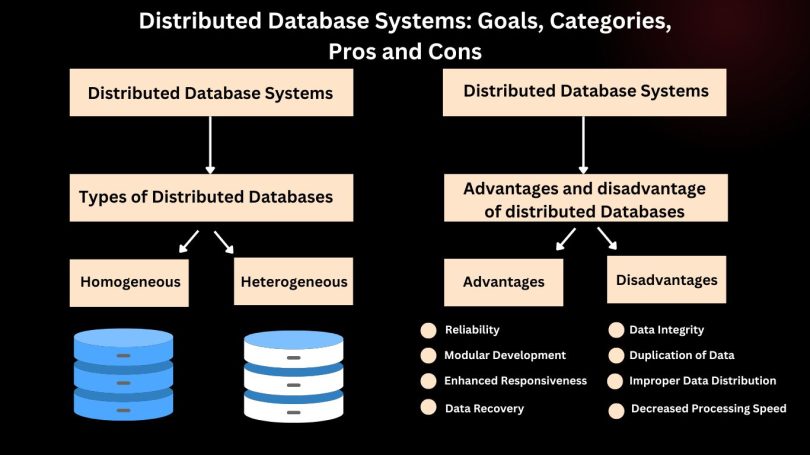Definition:
A “distributed database” system refers to a collection of linked databases within a “computer network”. Differentiating from a centralized database restricted to only a single system. The distributed database is spread across different computer networks or a number of databases. Managing data becomes crucial for contemporary business operations to enable global business processes.
Features:
To achieve seamless synchronization of processes and data across a platform or network, and to overcome geographical barriers, a centralized database management system is used.
This setup constitutes an independent local database that is accessible to every user, regardless of their geographical whereabouts.
The fundamental query arises: what is the distribution of data among different computer systems across different locations of a computer network?
Goals of Distributed Database:
A distributed database management system mainly aims to distribute data over different locations.
Several goals underpin the distribution of data; the former one is a framed picture that depicts the clear sky and the latter one is a painting which displays a hybrid plant.
Reliability:
In a distributed database management system, if one connected computer system fails to function, other computers can instantaneously take over tasks without a hitch, thus improving reliability.
Availability:
Even if a computer server encounters a malfunction and stops working at any point in time, other computer servers can handle the requested tasks, therefore, uninterrupted availability is guaranteed.
Performance:
Information and data stored in the distributed database management systems can be accessed from different places, hence making the handling easier and the maintenance simple.
Types of Distributed Databases:
Distributed database systems are categorized into two types based on data and storage.
- Homogeneous:
- The homogeneous database system implies a network where all sites/systems display uniformity.
- This working system, “database management system”, and “data structure” employed across all locations originate from a single “vendor”.
- Accessing and modifying information in a homogeneous database system is simple and without hassles.
- Heterogeneous:
- A diverse “distributed database management system” comprises a network of multiple “databases” that employ various database systems.
- These systems are capable of storing data across different storage devices and utilizing different operating systems, as well as various types of database management systems such as “relational”, “network”, or “hierarchical”.
- Query processing in such “heterogeneous” systems tends to be more complex.
Advantages of Distributed Database Systems:
Reliability:
Distributed database management systems are more reliable because the failure of one connected system does not impede the system’s performance. Operations continue uninterrupted, differentiating it from the conventional database management systems.
Low Communication Cost:
Data and information residing locally in a distributed database management system result in minimal communication costs, leading to data manipulation and communication being less laborious and economical.
Modular Development:
Modular development methodology within distributed database management systems allows easy integration and plugging of additional systems. Integration with the distributed database system is flawless.
Enhanced Responsiveness:
Centralized installation of all computer systems enables fast query processing within distributed database management systems thanks to centralized processing of database management systems.
Data Recovery:
Distributed database management systems provide efficient data recovery mechanisms, enabling quick and smooth data restoration in case of system failures or disruptions.
Disadvantages of Distributed Database Systems:
Data Integrity:
The decentralized characteristic of distributed database systems makes data integrity hard to maintain. Information being updated on different sites, making consistency and accuracy difficult and complex naturally.
Duplication of Data:
Duplication of data of the same type across different systems is the reason for data redundancy within distributed database management systems. This redundancy results in a huge amount of storage space being consumed across different computer systems, thus aggravating storage issues and inefficiencies.
Improper Data Distribution:
Inadequate distribution of data across systems can lead to sluggish response times during query processing. Replicating the same data across different computers can exacerbate issues within distributed database management systems, hindering overall performance and efficiency.
Decreased Processing Speed:
Ad hoc and extensive communication required to answer even simple queries may degrade performance dramatically within distributed database systems.
Thus, as a result, finding answers to specific questions can take a long time owing to the inherent complexities in communication and data retrieval across distributed networks.
Conclusion:
Distributed database systems are a very attractive option to conventional, centralized databases, providing features like high availability, scalability and performance. These systems distribute data across different locations, thereby providing geographical flexibility and are able to survive hardware failures, ensuring non-stop operation. Nevertheless, distributed databases have their own set of problems just like any other technology. Data integrity and efficient handling of data duplication demands good planning and management. The critical thing to know about your organization and the pros and cons involved are to be considered before entering the world of distributed databases. This article has laid the groundwork for such systems, allowing you to make reasoned judgments about their usefulness for your data management strategy.



